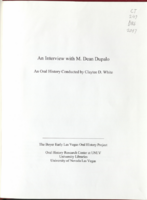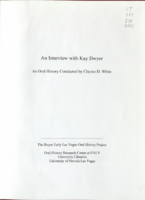Search the Special Collections and Archives Portal
Search Results

Transcript of interview with David Bruce Dill by Luise A. Soholt, March 13, 1975
Date
1975-03-13
Archival Collection
Description
On March 13, 1975, Luise Soholt interviewed Dr. David Bruce Dill (born 1891 in Eskridge, Kansas) about his experience as a researcher in physiology, specifically in Boulder City, Nevada. Dill first discusses his educational background in physiological research, including studies done around the world, and his eventual interest in the effects of heat on the workers of Boulder Dam. Dill then discusses the topics and findings of some of his studies, including one on heat cramps and one on the comparison between sweating in a dog and that in a human. Dill also discusses the use and purpose of salt tablets.
Text

Transcript of interview with Frank Cuti by Hans Kohls, February 25, 1979
Date
1979-02-25
Archival Collection
Description
On February 25, 1979, Hans Kohls interviewed Frank Cuti (b. 1904 in Pittsburgh, PA) about his experiences in the gaming industry in Nevada. Cuti first describes his work as a dealer in properties such as the Frontier Club during the 1940s. He then describes how the Strip developed from that point, naming casinos such as the El Rancho, Club Bingo, and the Flamingo. Cuti also discusses topics such as the nature of competition between properties, the problems with cheaters, and the involvement of the mob. He additionally provides his opinions on the involvement of unions in casinos and how dealing in the casinos has changed over the years. In the latter part of the interview, Cuti describes working as a floor man, and he talks about Howard Hughes’s influence on the development of Las Vegas.
Text

Transcript of interview with Harvey N. Dondero by Iskander A. Batlouni, February 26, 1981
Date
1981-02-26
Archival Collection
Description
On February 26, 1981, collector Iskandar A. Batlouni interviewed Harvey N. Dondero (born November 12, 1909 in Hawthorne, Nevada) in his office in Las Vegas, Nevada. As a member of the Las Vegas Board of Education, Mr. Dondero discusses relocating to Las Vegas in 1931 to teach at Las Vegas High School. During this interview, Mr. Dondero also discusses the Boulder (Hoover) Dam, the gaming industry, school integration, the Westside, the Strip, Howard Hughes, Block 16, and the growth of Las Vegas from a sleepy railroad town to a thriving metropolis.
Text

Transcript of interview with Harvey N. Dondero by Elizabeth N. Patrick, August 9, 1984
Date
1984-08-09
Archival Collection
Description
On August 9, 1984, collector Elizabeth N. Patrick recorded an address by local long time educator, Harvey N. Dondero (born November 12, 1909 in Hawthorne, Nevada) before the Kiwanis Club at the Fremont Hotel in Las Vegas. This address includes Dondero’s observations on the growth of the school system in Las Vegas, Nevada. After the address, Dondero receives a Distinguished Service Award, from the Kiwanis Club of Uptown Las Vegas, as a token of appreciation for his fifty-three years of dedication to children and youth education in Nevada. Dondero also answers questions posed by audience members, regarding the future of Nevada’s education system.
Text

Transcript of interview with Thalia Dondero by Claytee D. White, March 6, 2014 and April 2, 2014
Date
2014-03-06
2014-04-02
Archival Collection
Description
Thalia Dondero is most famous for being the first woman elected to the Clark County Commission. She ran her first successful campaign in 1974 and held office for twenty years. While on the commission, Dondero helped to create Red Rock Canyon and Valley of Fire state parks, to modernize McCarran International Airport and University Medical Center, and served on the Water Authority Board. She served as a member of the Board of Regents for the Nevada System of Higher Education for twelve years after retiring from the County Commission in 1994. Dondero died September 4, 2016 from complications from congestive heart failure. Thalia Marie Dondero was born January 23, 1920. Her father, Doyle Sperry, was a taxidermist and her mother, Sylvia Peck, was a violinist and worked in a laundry. She lived in both Colorado and Wyoming before her family settled in Bakersfield, California. Dondero moved to Las Vegas in 1943 when her employer took a job with Basic Magnesium, Inc. and requested that she follow him. On June 21, 1946 she married Harvey Dondero who taught English and journalism for local high schools,. The couple had two daughters and three sons together. Dondero was very active in her community. While her children were in school, she volunteered for the Parent Teacher Association and even served as the organization’s president. She was also very active with local Boy Scouts and Girl Scouts troops in Las Vegas. She served as executive director of the girl scouts and was instrumental in creating the Foxtail Girl Scout Camp at Mount Charleston. Throughout her life, Dondero volunteered with a number of Las Vegas organizations, including the Junior League, the International Women’s Foundation, and the Gilcrease Foundation.
Text

Transcript of interview with Ron Donoho by Craig Brenner, February 28, 1978
Date
1978-02-28
Archival Collection
Description
On February 28, 1978, Craig Brenner interviewed Ron Donoho (b. 1929 in Amboy, IL) about some historical aspects on the history of Southern Nevada law enforcement. The first portion of the interview involves a discussion of the history of sheriffs in the Clark County Sheriff’s Office and eventually the Las Vegas Metropolitan Police Department. Donoho mentions various sheriffs, including Charles Corkhill, who was sheriff when Clark County formed in 1909, as well as Sam Gay, Joe Keate, Gene Ward, Glen Jones, “Butch” Leypoldt, and then-sheriff Ralph Lamb. Donoho spoke somewhat about the performance of some of these sheriffs as well as the political factors involved during their leadership. The latter part of the interview includes a list of fallen officers who were killed in the line of duty in Southern Nevada, dating back to Ernest May’s death in 1933. Donoho, who researched much of the material of the interview, also spoke several times about his personal familiarity and acquaintance with some of the law enforcement officials mentioned.
Text

Transcript of Interview with Michael Drakulich by Jane Finfrock, May 8, 1979
Date
1979-05-08
Archival Collection
Description
On May 8, 1979, Jane Finfrock interviewed Michael “Mike” Drakulich (born 1924 in Kimberly, NV) about his experiences growing up in Nevada. Drakulich mainly describes his career from graduating college to holding several teaching and coaching positions at the University of Nevada, Las Vegas, positions which included professor, golf coach, and athletic director. He also discusses the growth of the university, important figures in sports coaching at the university, and the growth of Las Vegas in general.
Text

Transcript of interview with Martin Dean Dupalo by Claytee D. White, October 24, 2005
Date
2005-10-24
Archival Collection
Description
Martin Dean Dupalo was born February 20, 1967. His parents were Eva Auge, a German citizen, and Milton Dupalo. Martin shares many stories and anecdotes concerning his family background, his father's 21 year military career, his mother's tribulations in WWII Berlin, and the many sites the family visited all over the world. Martin gives a wealth of details regarding Las Vegas and UNLV in the seventies and eighties. He lists the schools he attended in Clark County and recalls some of the friends and professors his father knew while attending UNLV. Martin graduated from Eldorado High in 1985, attended UNLV, and was selected for a Truman Congressional Scholarship at Carnegie Mellon in Pittsburgh, Pennsylvania. He describes the house and surrounding area in which he and his father and brother, Michael Dean, lived. He also includes comments and anecdotes regarding entertainment in the Vegas Valley. After a stint as a fire fighter, four years in the Air Force and Air Force Reserve, and a brief marriage, Martin began teaching at UNLV in 2003. He discusses race relations as he has experienced them in his family, the military, Las Vegas, and at UNLV. His closing comments are in regard to war, world population, and the possibility of peace.
Text

Transcript of interview with Kay C. Dwyer by Claytee D. White, August 16, 2000
Date
2000-08-16
Archival Collection
Description
Kay Dwyer was born August 30, 1934 to James and Eileen Crawford. Her father attained a job as an accountant with Basic Magnesium Incorporated in 1942. This meant that the family moved to Henderson, Nevada, which was a brand new community back in the early 1940's. The BMI plant, which manufactured magnesium for bombs and other war materials, is discussed throughout the interview. The interview begins with Kay reading a composition that she wrote entitled, "Our Summer of 1942 and More." In the reading she talks about the early years of her life when she first moved to southern Nevada. Kay gives remarkable details about the towns of Basic and Henderson (Basic became the town of Henderson) were like during this historic period. In 1952, she graduated from Basic High School and then moved to Los Angeles to attend Pepperdine University for two years. She moved back to the Las Vegas area and started a family with Stanly Hardy with whom she had three children. Sadly, at age 31 Stanly passed away from pancreatic cancer. After a break, Kay decided to go back to school and graduated from Nevada Southern University (now UNLV). Upon graduation, she immediately began teaching at Clark High School. In 1968, Kay married George Dwyer after being a widow for five years. Later, she taught at Las Vegas High School where she would go on to spend the next 25 years until 1995. This interview is an excellent resource for quality information pertaining to the early years of Southern Nevada. Kay Dwyer's extraordinary experiences provide us with a special look at the history of Las Vegas.
Text

Transcript of interview with Marion B. Earl by Robert A. Pearce, March 13, 1976
Date
1976-03-13
Description
On March 13, 1976, Robert Pearce interviewed attorney Marion B. Earl (Born September 13, 1897 in Bunkerville, Nevada) at his home in Las Vegas, Nevada. Marion relocated to Las Vegas in 1923. During the interview Marion discusses serving as a member of the board of directors for the Chamber of Commerce, and then being elected president of the chamber in 1941. He also discusses being elected justice of the peace in 1934, and serving for two terms. He offers additional insight on the growth of Las Vegas and the history of Southern Nevada.
Text
Pagination
Refine my results
Content Type
Creator or Contributor
Subject
Archival Collection
Digital Project
Resource Type
Year
Material Type
Place
Language
